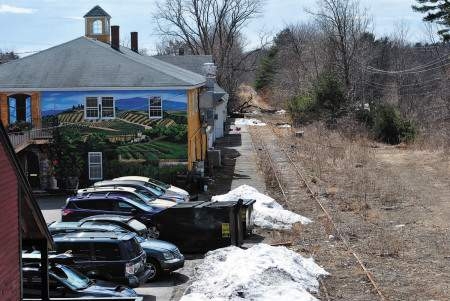Trail envisioned to link Hampton to Portsmouth
By Nick B. Reid
Hampton Union , March 31, 2013
[The following article is courtesy of the Hampton Union and Seacoast Online.]

This unused railroad, seen from Exeter Road in Hampton,
used to carry freight to nearby Foss Manufacturing until
about two years ago [Nick B. Reid photo]
State planners acquired important funding for the purchase of 10 miles of abandoned railway between Hampton and Portsmouth on Friday.
The land targeted for acquisition is owned by Pan Am Railways and hasn’t been used for years. It’s directly north of a 4.5-mile section of the same track going south from the center of Hampton into Seabrook that was bought by the state in 1999. Supporters of the acquisition envision a rail trail for bikers and hikers or an alternate route for cars with a bike lane that would stretch across the Seacoast.
Tom Jameson of the N.H. Department of Transportation said DOT officials met with a Congestion Mitigation and Air Quality (CMAQ) advisory board Friday morning, which agreed to fund the project that Seacoast lawmakers said “will have numerous and long-lasting benefits for the state, our towns and the entire Seacoast.”
A bipartisan coalition of state representatives from Hampton, North Hampton, New Castle, Rye, Greenland and Portsmouth recently wrote a letter to NHDOT Commissioner Chris Clement detailing their support for the purchase. Jameson said the onus is on Clement to take the next step.
Rep. Chris Muns, D-Hampton, was among lawmakers who wrote, “We urge the NHDOT to pursue acquisition of the newly abandoned section of the corridor when it is offered for sale and we endorse your intent to utilize (Congestion Mitigation and Air Quality) program funds to support the acquisition.”
The state has right of first refusal on the land.
CMAQ is a federal program implemented to support surface transportation projects and other efforts that contribute air-quality improvements and provide congestion relief, according to the Federal Highway Administration Web site.
Rep. Fred Rice, R-Hampton, said he’s a supporter of using that right-of-way to add two additional lanes of north-south traffic through Hampton to decrease traffic congestion.
“If we’re going to get any commercial growth in town the only other place you’ve got is if you made the right-of-way a two-lane road and open another commercial front,” he said.
Rice noted that plan fits in with the concept CMAQ is designed to support. “If you had four lanes going through Hampton instead of two, obviously it’s an air-quality improvement because you’ve got less cars sitting and idling,” he said.
Others envision a rail trail that would support the East Coast Greenway project, which seeks to create a trail from Maine to Florida connecting all the major cities along the way and providing hikers and bicyclists a traffic-free path.
“It makes development of a rail-to-trail multi-use facility and specifically the N.H. segment of the East Coast Greenway possible. The corridor’s wide right-of-way provides space to allow multiple uses,” according to the lawmakers’ letter to Clement.
The conversation regarding the best use of the land would develop only after the state acquires the corridor. Jameson said the goal “would be to purchase the corridor and then do whatever basic maintenance is needed to create a surface so it’s usable.”
What will certainly happen, according the lawmakers’ letter, is that the acquisition “will prevent the fragmentation of ownership and future development that would be incompatible with the corridor’s use as a transportation facility, and preserve it for a variety of potential future transportation and utility uses.”
Supporters say the land “will connect large residential, commercial, tourist and employment centers in our Seacoast communities with a corridor that is safe and efficient for bicycle and pedestrian travel, and that simultaneously serves as a transportation alternative, a regional recreational resource and significant tourist attraction.”
Pan Am quoted the price of the railroad at $100,000 in 2011, shortly after it was abandoned. Jameson said the next phase is a negotiation between the state and Pan Am.